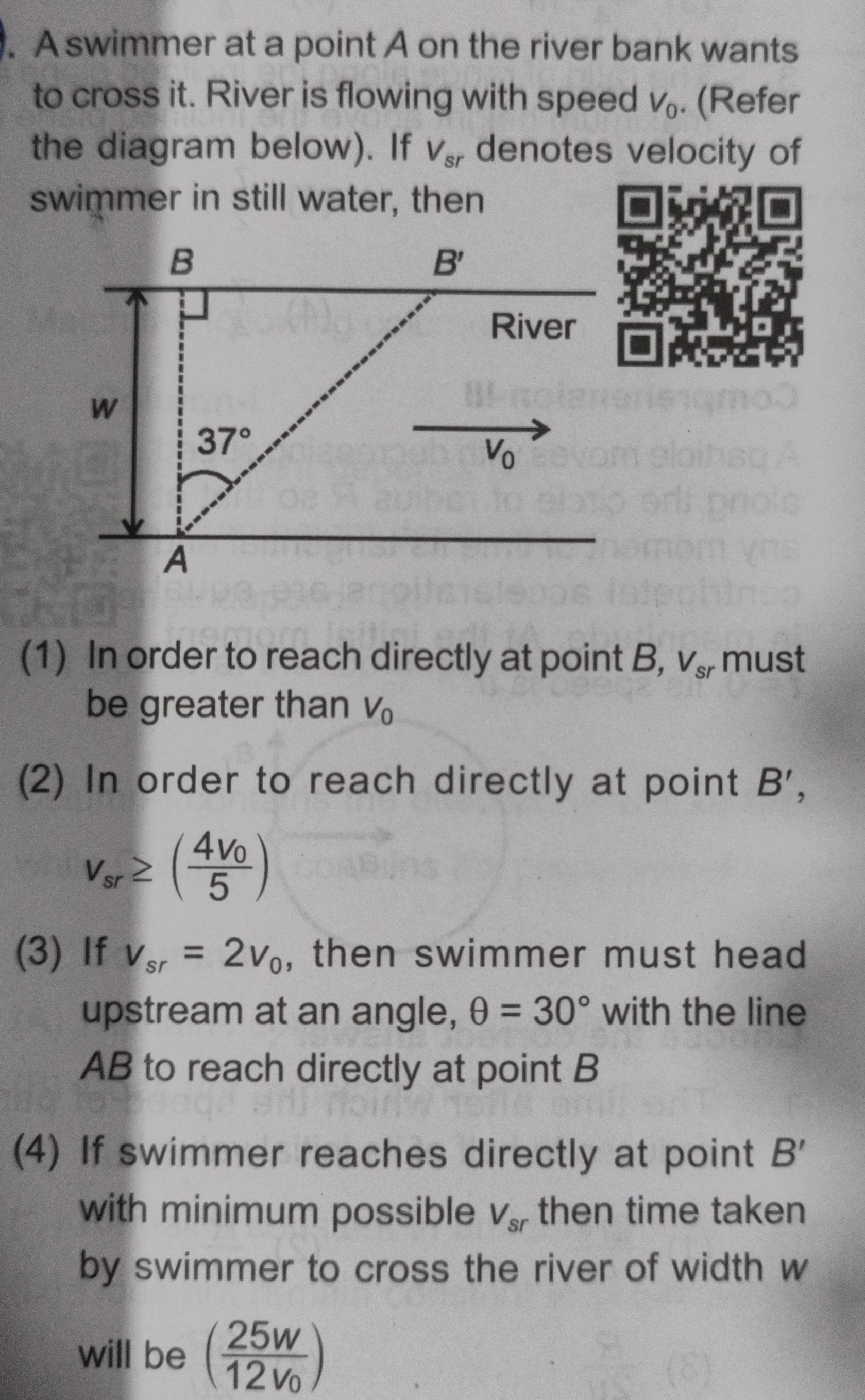Question
Question: A swimmer at a point A on the river bank wants to cross it. River is flowing with speed \(v_0\). (Re...
A swimmer at a point A on the river bank wants to cross it. River is flowing with speed v0. (Refer the diagram below). If vsr denotes velocity of swimmer in still water, then

In order to reach directly at point B, vsr must be greater than v0
In order to reach directly at point B', vsr≥(54v0)
If vsr=2v0, then swimmer must head upstream at an angle, θ=30∘ with the line AB to reach directly at point B
If swimmer reaches directly at point B' with minimum possible vsr then time taken by swimmer to cross the river of width w will be (12v025w)
(1), (2), (3), (4)
Solution
The problem involves concepts of relative velocity, specifically in the context of river-swimmer problems. We will use a coordinate system where the x-axis is along the river flow and the y-axis is perpendicular to the river flow (from A to B).
Let:
- v0 be the speed of the river. So, vr=v0i^.
- vsr be the speed of the swimmer in still water (velocity of swimmer with respect to river).
- vs be the velocity of the swimmer with respect to the ground.
The relation is vs=vsr+vr.
Let's analyze each option:
Option (1): In order to reach directly at point B, vsr must be greater than v0.
To reach point B, the swimmer must have a net velocity perpendicular to the river flow, i.e., the x-component of vs must be zero. Let the swimmer head upstream at an angle α with the y-axis (line AB). Then, vsr=−vsrsinαi^+vsrcosαj^. The resultant velocity is vs=(v0−vsrsinα)i^+vsrcosαj^. For the swimmer to reach point B, the x-component must be zero: v0−vsrsinα=0⟹vsrsinα=v0. Since the maximum value of sinα is 1, for a solution to exist, we must have v0≤vsr×1, i.e., vsr≥v0. If vsr=v0, then sinα=1, which implies α=90∘. In this case, the swimmer heads directly upstream. The velocity component across the river is vsy=vsrcos90∘=0. This means the swimmer cannot cross the river. Therefore, for the swimmer to successfully reach point B, vsr must be strictly greater than v0. So, option (1) is correct.
Option (2): In order to reach directly at point B', vsr≥(54v0).
Point B' is at an angle of 37∘ with the line AB. This means the net velocity vector vs must be directed at an angle of 37∘ with the y-axis (perpendicular to the river flow), towards the downstream side. Let vsx and vsy be the x and y components of vs. Then, vsyvsx=tan37∘=43 (since tan37∘≈3/4). For the swimmer to reach B', the swimmer must head upstream. Let the swimmer head upstream at an angle α with the y-axis. vsr=−vsrsinαi^+vsrcosαj^. vs=(v0−vsrsinα)i^+vsrcosαj^. So, vsx=v0−vsrsinα and vsy=vsrcosα. Using the condition vsyvsx=43: vsrcosαv0−vsrsinα=43 4(v0−vsrsinα)=3vsrcosα 4v0=3vsrcosα+4vsrsinα 4v0=vsr(3cosα+4sinα) vsr=3cosα+4sinα4v0.
To find the minimum value of vsr, the denominator (3cosα+4sinα) must be maximum. The maximum value of acosθ+bsinθ is a2+b2. Here, a=3,b=4. So, the maximum value is 32+42=9+16=25=5. Thus, the minimum vsr is vsr,min=54v0. Therefore, for the swimmer to reach B', vsr must be greater than or equal to 54v0. So, option (2) is correct.
Option (3): If vsr=2v0, then swimmer must head upstream at an angle, θ=30∘ with the line AB to reach directly at point B.
From the analysis of Option (1), to reach point B, we need vsrsinα=v0, where α is the angle with the line AB (y-axis). Given vsr=2v0. (2v0)sinα=v0 sinα=21 α=30∘. So, the swimmer must head upstream at an angle of 30∘ with the line AB. So, option (3) is correct.
Option (4): If swimmer reaches directly at point B' with minimum possible vsr then time taken by swimmer to cross the river of width w will be (12v025w).
From Option (2), the minimum possible vsr to reach B' is vsr,min=54v0. This minimum occurs when 3cosα+4sinα=5. This implies cosα=3/5 and sinα=4/5. (This corresponds to α≈53∘). The time taken to cross the river of width w depends only on the component of velocity perpendicular to the river flow, which is vsy. vsy=vsrcosα. Substitute the values for minimum vsr: vsy=(54v0)×(53)=2512v0. The time taken T=vsywidth=12v0/25w=12v025w. So, option (4) is correct.
All four given options are correct.
The final answer is (1), (2), (3), (4)
Explanation of the solution:
- Option (1): To reach point B (straight across), the swimmer's velocity component parallel to the river must cancel the river's velocity. This requires vsrsinα=v0. For a real angle α, sinα≤1, so vsr≥v0. If vsr=v0, α=90∘, meaning the swimmer heads directly upstream, resulting in zero velocity perpendicular to the flow, thus unable to cross. Hence, vsr>v0 is necessary.
- Option (2): To reach point B' at 37∘ downstream, the ratio of the swimmer's net velocity components must be vsx/vsy=tan37∘=3/4. If the swimmer heads upstream at angle α with the perpendicular, vsx=v0−vsrsinα and vsy=vsrcosα. Substituting these into the ratio and solving for vsr gives vsr=3cosα+4sinα4v0. The minimum vsr occurs when the denominator is maximum, which is 32+42=5. Thus, vsr,min=54v0.
- Option (3): For reaching point B, we have vsrsinα=v0. Given vsr=2v0, this becomes 2v0sinα=v0, leading to sinα=1/2, so α=30∘.
- Option (4): When vsr is minimum to reach B', vsr=54v0. This occurs when cosα=3/5 and sinα=4/5. The time to cross the river of width w is T=w/vsy. The component vsy=vsrcosα=(54v0)(53)=2512v0. Substituting this, T=12v0/25w=12v025w.
Answer: The correct options are (1), (2), (3), (4).
